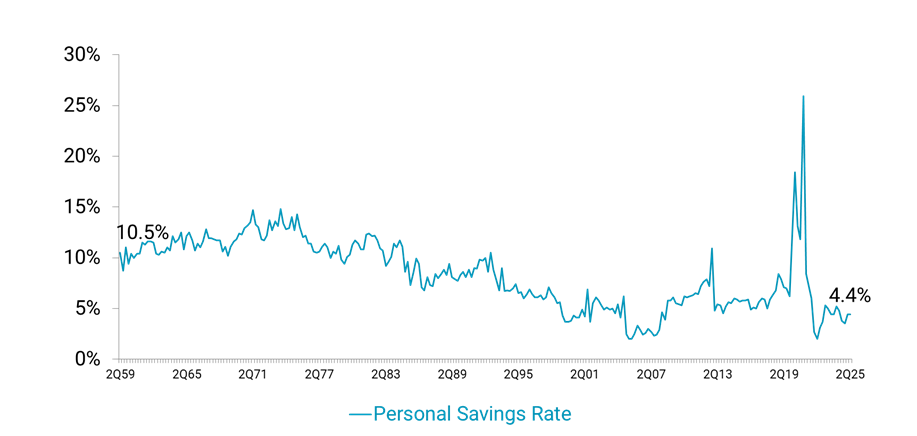The personal savings rate is an important economic metric that provides a pulse on household resilience. It’s also a benchmark credit unions can use to measure their role in strengthening household stability, but to do that, they must have a firm understanding of what it is and what comprises it. Armed with this insight, credit union leaders can leverage the data to make better-informed decisions about the needs of their membership.
What Is The Personal Savings Rate?
Did You Know?
The Bureau of Economic Analysis publishes a range of economic statistics for the United States, including gross domestic product (GDP), personal income spending (PCE), and the personal savings rate.
According to the Bureau of Economic Analysis, the personal savings rate is the percentage of people’s incomes left over after they pay taxes and make personal outlays for goods, services, and other necessities. That pot of money includes funds directed toward the stock market, deposits at banks and credit unions, and other acts of saving.
Economists and financial experts track and discuss the personal savings rate because it helps them understand American’s financial health and functions as an early indicator as to consumer confidence and the state of the economy. But what it means is up for fierce debate.
Economist John Maynard Keynes posited that there is a Goldilocks savings range for any economy. When people save too much, businesses must close because they lack a customer base. When consumers save too little, the economy suffers from lack of investment and overconsumption.
This is known as the “Paradox of Thrift.” But where to draw that line is up for interpretation.
A History Of Savings In The United States
A country’s personal savings rate often is as cultural as it is economic. As of July 2025, the most current data available, the U.S. personal savings rate stood at 4.4%.
This significantly lags the Eurozone — where Eurostat puts the savings rate at 15.2% in the first quarter of 2025 — and the United Kingdom — where the Office for National Statistics puts the savings rate at 10.9% in the second quarter of 2025. Closer to home, Statistics Canada puts the country’s savings rate at 5.0% at midyear.
Within the United States, though, 4.4% is remarkably low even when compared against historical data. From the beginning of the dataset in the 1950s through the early 1980s, personal savings in the United States hovered around 11%. In the mid-80s, it began a decades long descent into the low single digits, with a brief post-recession rise in the early 2010s and a giant spike during the COVID-19 pandemic, when government relief checks combined with weaker household spending sent the savings rate soaring. Subsequent inflation, however, ate away at nest eggs, and the rate continued its dramatic decline.
PERSONAL SAVINGS RATE
FOR U.S. HOUSEHOLDS
SOURCE: Bureau of Economic Analysis

Why Has The Savings Rate Fallen?
That’s a loaded question economists are trying to unpack. For Americans lower on the economic ladder, fighting inflation in their pocket books makes it more difficult to save. For younger Americans, paying student loans back has the same impact. But broadly, there are other macro reasons why Americans, even those of greater means, don’t save.
According to the Federal Reserve Bank of San Francisco, the “wealth effect” could be playing a role. That is a phenomena where an increase in the real value of assets makes people feel more finically secure and stimulates consumption. In today’s environment, people are treating high stock and home prices as money to spend even though these assets are not income. It is important to remember that capital gains aren’t included in the savings rate calculation, so the measure might not offer a complete picture of household wealth or savings behavior in the United States.
Another possible explanation for the falling savings rate could be that U.S. workers foresee higher wages in the future, mitigating the need to save in the present. Although this behavior could be prudent or imprudent depending on the circumstances, such an optimistic attitude would certainly be an explanation for American joie de vivre.
What Does The Savings Rate Mean For Credit Unions?
The personal savings rate is an important metric to understand because it serves as a key indicator of financial wellness. However, it is not the only factor, and credit union leaders must keep a few caveats in mind.
First, the savings rate is an average. It is not necessarily representative of any single credit union’s typical member. Given the varying circumstances among credit union members as a whole and even within the same cooperative, a member might be way above or way below this rate.
Second, as noted above, the savings rate does not account for capital gains like rising stock and housing prices. If a member holds a significant amount of stock or real estate, their savings rate might be understated.
Despite its limitations, the personal savings rate remains a useful baseline for evaluating share growth. If share growth is higher than the national rate, members are entrusting more of their savings to their credit union. If it’s lower, they’re putting a greater share elsewhere. Neither outcome is inherently good or bad — it’s context. The real opportunity lies in using this measure as a lens to better understand member behavior, refine strategy, and strengthen financial wellness. That’s where credit unions can turn this statistic into a springboard for action.